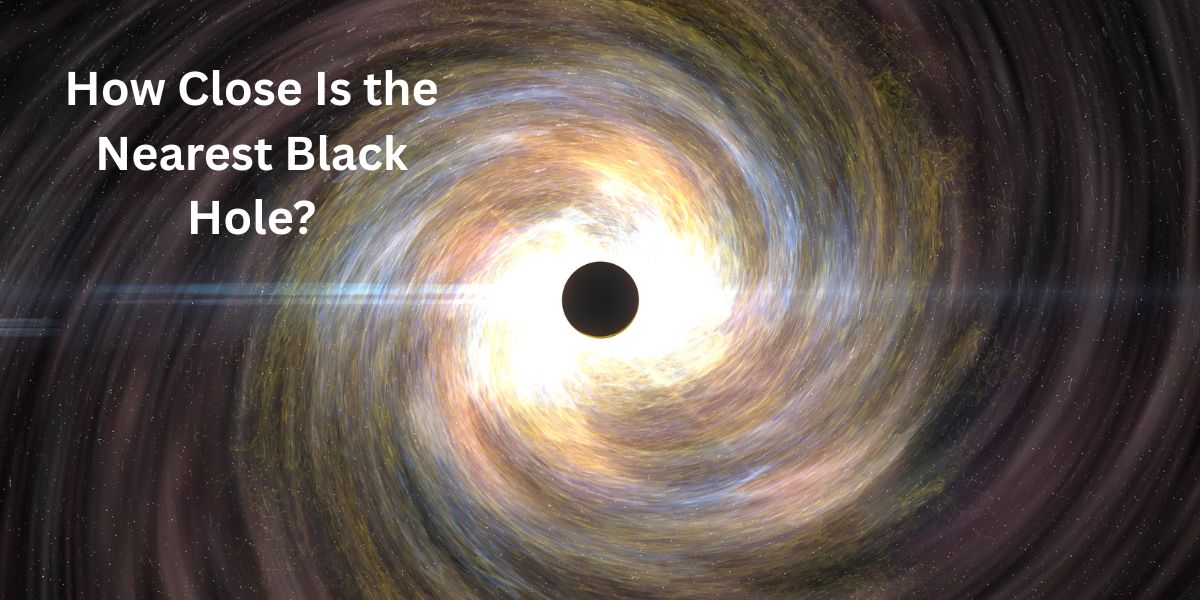Have you ever looked up at the night sky and wondered about black holes? These mysterious space objects are so strong that even light cannot escape them. They are like invisible space monsters, pulling everything nearby into them.
Scientists study black holes to learn more about how our universe works. But how far is the closest one to us? Could it ever come near Earth? Let’s find out—and don’t worry, we are safe!
So, how close is the nearest black hole, and should we be afraid?
What Is a Black Hole?
A black hole is a place in space where gravity is super strong. It forms when a very big star collapses. The pull is so powerful that nothing, not even light, can escape it.
Think of it like a giant vacuum cleaner in space. If something gets too close, it gets sucked in forever. But black holes don’t just roam around eating everything—they stay in one place unless something pushes them.
Fun Facts About Black Holes:
- Black holes can be big or small. Some are as tiny as an atom but have the mass of a mountain.
- The biggest black holes are called “supermassive” and sit at the center of galaxies.
- You can’t see a black hole directly, but scientists find them by watching how stars and gas move around them.
Where Is the Nearest Black Hole to Earth?
The closest known black hole to Earth is called Gaia BH1. It is about 1,560 light-years away from us. That means if you traveled at the speed of light (which is impossible for us right now), it would take 1,560 years to reach it.
To understand how far that is:
- 1 light-year = 5.88 trillion miles (9.46 trillion kilometers).
- Our Milky Way galaxy is about 100,000 light-years wide, so Gaia BH1 is still very close in space terms.
Is There a Black Hole Closer Than Gaia BH1?
Scientists keep searching. There might be smaller black holes even nearer, but we haven’t found them yet. Space is huge, and black holes are hard to spot!
Can a Black Hole Come Close to Earth?
No, the nearest black hole is too far to ever reach us. Even if it moved, space is so big that the chances are almost zero.
Black holes don’t “wander” like in movies. They stay where they are unless something huge, like a collision with another star, pushes them. Even then, space is mostly empty, so they won’t just bump into planets.
What If a Black Hole Came Near Earth?
- If one got close, its gravity would stretch and pull everything apart.
- But again, this is extremely unlikely. Earth is safe from black holes.
How Do Scientists Find Black Holes?
Since black holes are invisible, scientists use special tricks to find them:
- Watching Stars: If a star is moving strangely, a black hole might be nearby pulling it.
- X-rays: When gas falls into a black hole, it heats up and sends out X-rays that telescopes can detect.
- Gravity Waves: When two black holes collide, they create ripples in space called gravitational waves.
Did You Know?
- The first photo of a black hole was taken in 2019. It looked like a glowing ring with a dark center.
Could There Be a Tiny Black Hole Near Us?
Some scientists think tiny black holes might exist, but none have been found yet. Even if they do, they would be too small to harm Earth.
What Are Mini Black Holes?
- They could be as small as an atom but have the mass of a mountain.
- They might have formed right after the Big Bang.
- None have been detected near Earth.
What Happens If You Fall Into a Black Hole?
Falling into a black hole would be deadly. The gravity is so strong that your body would stretch like spaghetti—this is called “spaghettification.”
But don’t worry:
- No black hole is close enough to pull us in.
- You’d have to get very, very close for this to happen.
Conclusion
The closest black hole, Gaia BH1, is 1,560 light-years away—way too far to ever harm Earth. Black holes are fascinating but not dangerous to us. Scientists keep looking for more, but space is so huge that we are safe.
How many black holes are in the Milky Way?
Scientists think there could be 100 million black holes in our galaxy, but only a few dozen have been found so far.
What is inside a black hole?
No one knows for sure. The center, called a singularity, is where gravity is infinite, and physics breaks down.
Can the Sun become a black hole?
No. The Sun is too small. Only stars 20 times bigger than the Sun can form black holes.
How big is the biggest black hole?
The largest known black hole, TON 618, is 66 billion times the mass of the Sun.
Do black holes die?
Yes, but very slowly. They lose energy over trillions of years in a process called Hawking radiation.
Can we create a black hole on Earth?
No. We don’t have the technology to make something with that much gravity.
What happens when two black holes collide?
They merge into one bigger black hole and send out gravitational waves.
Can a black hole destroy a galaxy?
No, but the supermassive ones at galaxy centers control how stars move around them.
How fast do black holes spin?
Some spin nearly the speed of light, making space twist around them.
Are wormholes real?
Wormholes are only theoretical. No one has found proof they exist.
